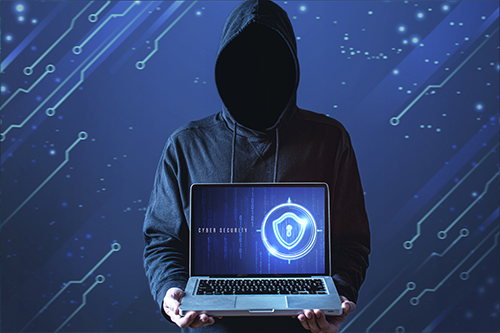As 2023 draws to a close, the world of cybersecurity is more important than ever. In an increasingly digitized world, protecting our data and IT systems has become a crucial issue. Whether we're talking about large corporations or private individuals, we're all exposed to the threat of cyber attacks. Let's take a look at this year's biggest cybersecurity threats and how to protect yourself against them.
Cyber attacks: a constantly evolving threat
At the heart of cybersecurity, cyberattacks are a constantly evolving threat. Cybercriminals are redoubling their ingenuity to bypass our protections and gain access to our precious data.
In 2023, the number of attacks increased again, affecting both large companies and small structures. Cyber attacks have become an omnipresent threat in the workplace, requiring constant vigilance on the part of employees.
Visit malwareThey have diversified and adapted to new technologies. They can sometimes take control of our devices without our knowledge, gaining access to sensitive information.
The Cloud, a prime target for cybercriminals
The Cloud has become an essential component of our IT systems. It enables us to store large amounts of data and make it accessible at any time. But this new way of managing our information has also attracted the attention of cybercriminals.
In 2023, attacks on Cloud services have increased significantly. Cybercriminals are seeking to access these immense reservoirs of data and use them for malicious purposes. Companies have therefore had to redouble their efforts to secure their data stored in the Cloud.
Data protection: a major challenge for companies
Data protection has become a major issue for companies. With cyber-attacks on the increase, organizations need to implement robust security measures to protect their systems and data.
In 2023, companies were faced with new data protection regulations. They also had to invest in more effective security software to guard against attacks.
Employees, the weak link in cybersecurity
Employees are often considered the weakest link in cybersecurity. Indeed, a mistake on their part can give a cybercriminal access to the company's system.
By 2023, companies have realized the importance of training their employees in cybersecurity. Training programs have been set up to make them aware of the risks and teach them how to protect themselves against cyber-attacks.
How do you protect yourself against cyber attacks?
Protecting yourself against cyber attacks is a real challenge. However, there are several steps you can take to strengthen your security. First of all, it's essential to invest in good security software. Up-to-date antivirus software can protect you against many threats.
Secondly, you need to back up your data regularly. In the event of an attack, you'll be able to recover your information without too much damage. Finally, it's crucial to train your employees in cybersecurity. A good understanding of the risks involved can go a long way towards preventing attacks.
Remember, cybersecurity is everyone's business. Everyone must play their part in protecting their data and those of their company. So stay vigilant, and take the necessary steps to ensure your online security.
Social engineering and identity theft actions
Social engineering and identity theft are two cyberthreats that have particularly marked the year 2023. These ancient scams have adapted to the digital age, and now take a variety of forms: phishing, phishing, online identity theft...
L'social engineering refers to all techniques designed to manipulate a person into revealing confidential information. By pretending to be someone they trust, cybercriminals often succeed in convincing their victims to reveal sensitive information.
L'identity theft is another major threat. It consists in using another person's identity, generally with the aim of committing malicious actions. In 2023, cases of identity theft increased significantly, requiring increased vigilance on the part of users.
The emergence of denial-of-service attacks
Denial of service (DoS) is an attack designed to render a computer service or system unavailable. Denial-of-service attacks increased significantly in 2023. They often take the form of request overloads on a server, rendering it unusable.
A more sophisticated variant, distributed denial of service (DDoS), has also been on the increase. These attacks involve a multitude of infected computers, known as "botnets", simultaneously overwhelming the target server.
This threat is of particular concern to businesses, as it can affect the availability of their online services, resulting in financial losses and loss of customer confidence.
The Evolution of Internal Threats
When it comes to cybersecurity, threats don't always come from outside. Visit internal threats were a major issue in 2023. These are usually caused by employees, whether they act through negligence, dissatisfaction or are manipulated by external attackers.
Employees with access to sensitive information can be the target of social engineering attacks. They may also make unintentional errors that lead to data breaches.
Faced with this situation, companies have had to strengthen their internal security, both in terms of technology and human resources. They had to be vigilant in managing user access and rights, and avoid data manipulation errors.
Conclusion
In conclusion, the year 2023 saw an evolution and multiplication of cybersecurity threats. Malware, attacks on the Cloud, social engineering, denial of service, insider threats... these are just some of the challenges facing businesses and individuals.
Data protection and information systems security must remain a priority for everyone. It is essential not only to invest in high-performance security solutions, but also to regularly educate and train employees in these issues. Finally, cybersecurity is a constantly evolving field. In the face of ever more ingenious cybercriminals, you need to keep a constant watch and constantly adapt your practices and tools. In the face of these challenges, let's not forget that cybersecurity is everybody's business.

